Plants are living organisms just like animals and humans. They have particular characteristics that differentiate them from each other. In this article, we will explain the characteristics, classification of plants, their parts and the process of photosynthesis.
Some live for many years, like the araucaria and others live very short periods. They can grow many feet like some trees, or just a few inches. They can live both on land and in water.

There are three kingdoms in nature: Animal, vegetable and mineral. Plants belong to the plant kingdom.
Characteristics of Plants for Kids
Table of Contents
Although plants have different shapes or looks, they all have characteristics in common.🌼
• They are living things because they are born, grow, nurture, reproduce and die.
• They are made up of cells. They are multicellular.
• Plants are autotrophic. Like other living things, plants need nourishment. How do they produce food and energy? Energy comes from food. But have you ever seen plants eating food? No, plants obtain their energy in another way. Unlike animals, plants are capable of producing their own food through a chemical process called photosynthesis. We will explain later.
• Relationship with the environment. Plants react to stimuli differently from animals. Despite not having a nervous system, plants perceive signals from the environment around them and produce some kind of response.
Read also: Nervous System for kids
Plants can even move. They do this in order to minimize harmful factors or to ensure food.
– Some flowers close at night to avoid cold injuries.
– Carnivorous plants move to catch insects that will become food.
– The main root moves downwards to obtain water and mineral nutrients from the depths.
– A shoot moves up to expose itself to sunlight.
These movements of plants in response to stimuli can be of two types: nastic movements and tropism.🌳
What is the difference between Tropism and Nastic movements in plants?
Tropisms are movements of the plant in response to an external stimulus that acts in only one direction. This movement is achieved through the growth of the plant towards the stimulus and the transformation is permanent. This type of growth is a very slow movement. Phototropism is the movement that plants execute in response to light stimuli.
Nastisms are rapid and reversible movements of the plant in response to the presence of an external factor. Unlike tropisms, they are not influenced by the direction of the stimulus. Nastisms are temporary movements. Once the stimulus has passed, the plant returns to its original state. An example of photonastic movement is the flowers that close at night, or the sunflower whose flowers follow the direction of the sun. An example of thermonastic movement is the tulip that opens when the temperature increases. Thermonastic is the response to certain temperatures.
The Different Parts of a Plant and their Functions
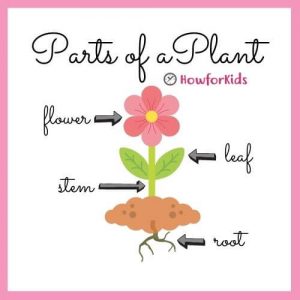
Plant Organs: What are the Organs of a Plant?
Plants, like humans and animals, are made up of organs that perform different functions. Most plants have three fundamental parts:
- Root.
- Stem.
- Leaves.
- Some also have flowers and fruits.
Roots
Plant Root Structures and Their Functions
What is the Function of a Plant’s Root System?
It is the plant organ that is usually found under the ground. The root system of a plant constantly provides the stems and leaves with water and dissolved minerals. Water is absorbed through a phenomenon called osmosis. They have one main root (the taproot) from which smaller branch roots emerge. When a seed germinates, the first root to emerge is called a radicle, or primary root.
Root Function in Plants
The four main functions of a root are 1) the absorption of water and inorganic nutrients, 2) the anchoring of the plant to the soil and its support, 3) the storage of food and nutrients, 4) the transport of water and minerals to the stem.
Stem
Stem: The Plant Body
The stem in plants is the organ that connects the roots with the leaves. In general, the stem grows upwards, seeking sunlight.
What is the function of the Stem in a Plant?
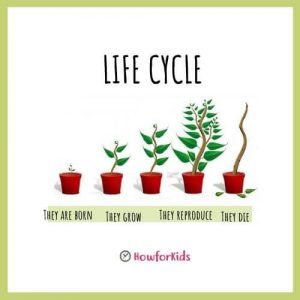
Stem Function in Plants
- Support leaves, flowers and fruits.
- Transport of water, food and minerals that enter through the roots (products of photosynthesis).
- Storage of carbohydrates.
Also Read: Food Groups for Children
Leaf
What is a Leaf? Leaves of a Plant
Leaves: Plant Lungs. How do Plants Breathe?
Leaves are the lungs of plants. They can have a variety of shapes and sizes. They are a very important part of plants due to the functions they perform. In general, they are green in color due to the presence of chlorophyll. Chlorophyll is the fundamental substance in the photosynthesis process. The leaves can change color according to the time of year.
Main Functions of a Leaf
In the leaves, respiration, perspiration and photosynthesis take place. Leaves are the “respiratory system” of plants. Respiration consists of absorbing oxygen from the atmosphere and exhaling carbon dioxide. This function mainly occurs at night.
In the leaves are the sets of chloroplasts that capture light. On the underside of the leaves, there are small (microscopic) holes called stoma that allow perspiration. It is made in the form of small “droplets” that appear on the surface of the leaves.

Parts of a Leaf and their Functions
• The Leaf blade: It is the flat part of the leaf also called the lamina. It has two faces, the top is called the upper side, and the reverse is called the underside. It contains the veins or nerves that are extensions of the petiole in the blade that form the skeleton, give consistency to the leaf, are more pronounced on the underside.
Leaf blade parts: Base, edge, upper side, underside, apex or tip.
The leaf base is the part of the blade where it joins the petiole and the edge is the outline of the blade. The vertex or apex is the part opposite to the base.
• Petiole: It is the filament that joins the leaf to the stem or branch.
• Sheath: It is the broadening that joins the petiole with the stem.
Flowers
Function of the Flower of a Plant
It is the reproductive organ of the plants.
The flowers usually have bright colors and scents. The fundamental function is the continuity of the species. Most flowers are hermaphroditic. This means that they have both male and female reproductive organs. The flowers can turn into fruits that contain the seeds that will guarantee the new generations of plants.
Parts of the Flower
The flower has several parts:
Protective Parts:
Calyx
It is made up of a set of small green leaves called sepals that are located on the outside of the flower. The calyx and corolla are the floral envelope, they have the function of protection of the reproductive organs.
Corolla
It is made up of a set of colored petals. The corolla has the function of attracting pollinators. These pollinators are animals or the wind, which carry pollen grains from one flower to another (or to the same one).
Reproductive Organs:
Stamens
They are the male organs of the flower. They are formed by a filament that ends in the anther. Inside which is pollen. It contains male sex cells.
Pistil
It is the female organ of the flower. It is bottle-shaped, with an opening (stigma), a long neck (style) and at its bottom it widens, forming the ovary, where the ovules are found. The pollen grains that contain the male cells travel to the ovary. During fertilization they unite with the ovum.
Floral peduncle: It is located at the base and joins the flower to the stem.
Fruits and Seeds
The flowers turn into fruits that contain seeds. As the seeds form, the protective parts wither and fall off. The tissues of the ovary wall form the fruit. The seeds when they germinate will give rise to new lives.
Plant Fun Fact
Is it “bad” to have Plants in the bedroom?
Is it true that plants consume our oxygen? Is it true that we should not sleep with plants in the rooms? Surely you have heard that sleeping with plants is dangerous because they consume oxygen during the night and release carbon dioxide.
Plants make their own food during the day through the process of photosynthesis releasing oxygen. And it is true that, at night, when they do not receive light, they consume oxygen and expel carbon dioxide. However, the amount of oxygen they need to survive is actually very small in relation to what humans need. It is not dangerous to decorate your bedroom with a plant.
The Plant Kingdom: Characteristics and Classification
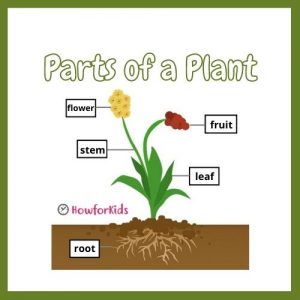
Classification of Plants
Plants can be classified in many different ways: according to the presence or absence of seeds, according to whether the plants produce flowers or not, according to the presence of stems, leaves and roots. The most accepted and popular plant classification is based on whether they are flowering plants (angiosperms) or non-flowering plants (gymnosperms).
This is another way to group the plants:
– Algae: They do not have true roots, stems, leaves, vascular tissue and have simple reproductive structures. They are distributed worldwide in the sea, in freshwater and in moist situations on land.
– Terrestrial plants: they are divided into:
• Non-vascular plants: In these plants there is no distinguishing root, stem, or leaves. They do not have conduction cups. For example, mosses, which live on dry land and humid places and absorb water throughout their bodies.
• Vascular plants: They may or may not have flowers.
– Flowering plants: They can be of two types: Angiosperms (they have their seeds enclosed in fruits such as orange). Gymnosperms (which have the seeds on modified leaves such as pine cones)
– Plants without flowers: Like ferns, which are plants made up of roots, stems, and leaves. They reproduce by spores.
Angiosperms are further classified according to the nature of the embryo in the seed in monocotyledonous and dicotyledonous plants. Cotyledons are the first primitive leaf that plants produce in their embryonic form. It will be your first tool to collect sunlight and photosynthesize, which is why this little leaf called cotyledon is so important.
- Dicots are plants that have seeds with two cotyledons, for example: Avocado, apple, cactus, cotton, orange, rose, tomato, guava, pear, papaya, sunflower, mango
- Monocots are plants that have seeds with a cotyledon such as: Tulip, banana, bamboo, sugar cane, corn.
Photosynthesis for Kids
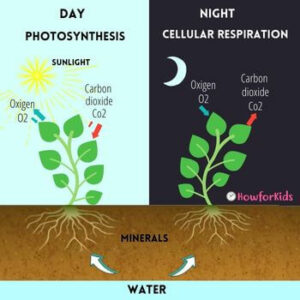
Plants are living beings capable of synthesizing their own food. They contain in their cells chloroplasts with a green pigment called chlorophyll. It is in charge of capturing sunlight to carry out this process.
Photosynthesis Drawing for Kids
What is Photosynthesis?
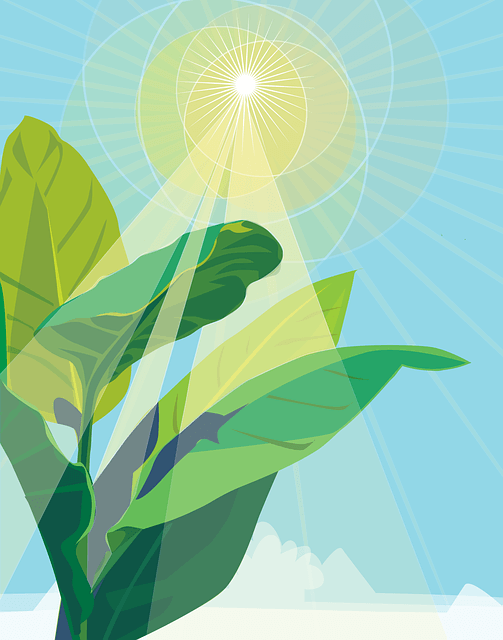
Plants are the main source of oxygen on planet Earth. They use sunlight for energy, get water from rain, and get carbon dioxide when they breathe. They need four basic things to live:
- Water.
- Sunlight.
- Chlorophyll.
- Carbon dioxide.
Plants breathe carbon dioxide just like humans breathe oxygen. They breathe in carbon dioxide and breathe out oxygen. This process is called photosynthesis. Plants capture sunlight using a green compound called chlorophyll.
Photosynthesis is the transformation of inorganic material into organic material. It is the production of sugar (called glucose C6H12O6) from C02 (carbon dioxide), minerals and water with the participation of sunlight.
Photosynthesis Process

• Water: Plants absorb water and minerals from the soil through their roots. The minerals are transported from the roots through fine conduits in the stem, branches and trunks to the leaves.
• Carbon dioxide: On the underside of the leaves are the stomata, which are small pores through which carbon dioxide from the air enters.
• Chlorophyll: It is a green pigment found in the chloroplasts of cells. Thanks to chlorophyll, plants are able to capture the energy of sunlight and convert it into chemical energy.
• Sunlight: From sunlight and carbon dioxide, it transforms raw sap into processed sap that constitutes the plant’s food. The raw sap is a mixture of water, mineral salts and other substances that are absorbed by the roots. The elaborated sap is synthesized in the leaves through photosynthesis that includes sugars, minerals and other substances that the plant requires for its growth and development.
As a result of this process, the plant produces oxygen that is released into the environment through the leaves.
Stages of Photosynthesis Diagram
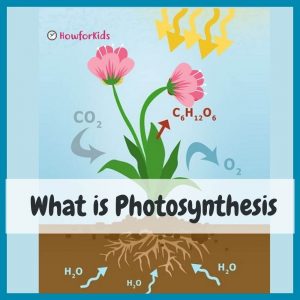
Plant Photosynthesis and Cellular Respiration
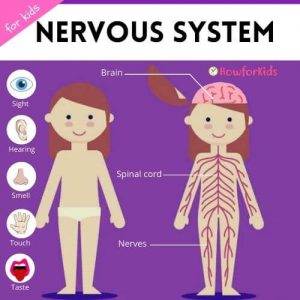
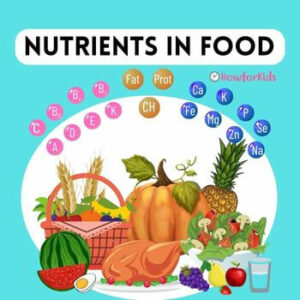
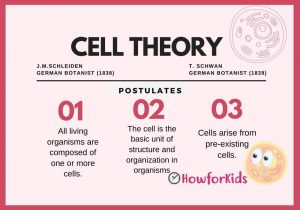
This helps me explain matters in a way my young students can understand.